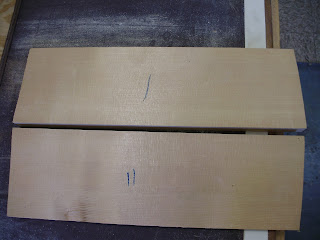Another great day working on the mandolin. I'm really getting into this!!
Today we worked on gluing up the body sides, did some additional carving on the neck and book matched and glued the top.
These are two piece of the sides that developed several small splits when being bent. The splits were glued and held together with wood blocks and 'c' clamps. After removing the clamps, the split were no longer visible.
This pic shows all the side pieces and blocks in the mold fully glued up. The small wedges near the top block are used to keep the sides snug to the block as the glue dries.
Here we're showing the quartersawn spruce top cut down the middle. (correction to a previous post: age of spuce drying is not 90 years, but has been drying since 1967).
After making sure the two pieces of the top were perfectly joined, we glued them together using these clamps. Once the glue had set, we ran the top thru the drum sander getting the bottom and top perfectly smooth and 14mm thick.
Here's the neck with the russ rod wrench opening formed and smoothed out. Got to use my wood carving tools on this. I knew they would come in handy!
This is the heal of the neck carved out and sanded. I used 100, 150, 220, steel wool and a wool sock (yes, like the sock you put on your foot!) to get a finish that is as smooth as glass.















